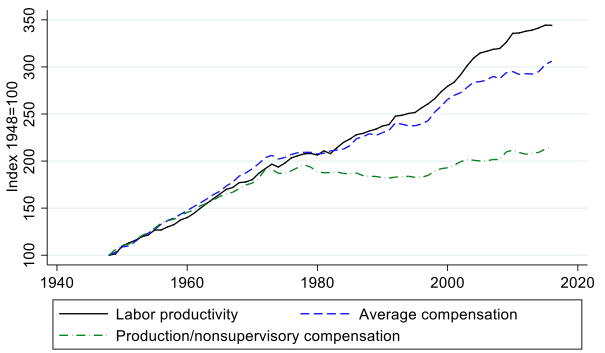Pay growth for middle class workers in the US has been abysmal over recent decades – in real terms, median hourly compensation rose only 11% between 1973 and 2016.1 At the same time, hourly labour productivity has grown steadily, rising by 75%.
This divergence between productivity and the typical worker’s pay is a relatively recent phenomenon. Using production/nonsupervisory compensation as a proxy for median compensation (since there are no data on the median before 1973), Bivens and Mishel (2015) show that typical compensation and productivity grew at the same rate over 1948-1973, and only began to diverge in 1973 (see Figure 1).
Figure 1 Labour productivity, average compensation, and production/nonsupervisory compensation 1948-2016
Notes: Labour productivity: total economy real output per hour (constructed from BLS and BEA data). Average compensation: total economy compensation per hour (constructed from BLS data). Production/nonsupervisory compensation: real compensation per hour, production and nonsupervisory workers (Economic Policy Institute).
What does this stark divergence imply about the relationship between productivity and typical compensation? Since productivity growth has been so much faster than median pay growth, the question is how much does productivity growth benefit the typical worker?2
A number of authors have raised these questions in recent years. Harold Meyerson, for example, wrote in American Prospect in 2014 that “for the vast majority of American workers, the link between their productivity and their compensation no longer exists”, and the Economist wrote in 2013 that “unless you are rich, GDP growth isn't doing much to raise your income anymore”. Bernstein (2015) raises the concern that “[f]aster productivity growth would be great. I’m just not at all sure we can count on it to lift middle-class incomes.” Bivens and Mishel (2015) write “although boosting productivity growth is an important long-run goal, this will not lead to broad-based wage gains unless we pursue policies that reconnect productivity growth and the pay of the vast majority”.
Has typical compensation delinked from productivity?
Figure 1 appears to suggest that a one-to-one relationship between productivity and typical compensation existed before 1973, and that this relationship broke down after 1973. On the other hand, just as two time series apparently growing in tandem does not mean that one causes the other, two series diverging may not mean that the causal link between the two has broken down. Rather, other factors may have come into play which appear to have severed the connection between productivity and typical compensation.
As such there is a spectrum of possibilities for the true underlying relationship between productivity and typical compensation. On one end of the spectrum – which we call ‘strong delinkage’ – it’s possible that factors are blocking the transmission mechanism from productivity to typical compensation, such that increases in productivity don’t feed through to pay. At the opposite end of the spectrum – which we call ‘strong linkage’ – it’s possible that productivity growth translates fully into increases in typical workers’ pay, but even as productivity growth has been acting to raise pay, other factors (orthogonal to productivity) have been acting to reduce it. Between these two ends of the spectrum is a range of possibilities where some degree of linkage or delinkage exists between productivity and typical compensation.
In a recent paper, we estimate which point on this linkage-delinkage spectrum best describes the productivity-typical compensation relationship (Stansbury and Summers 2017). Using medium-term fluctuations in productivity growth, we test the relationship between productivity growth and two key measures of typical compensation growth: median compensation, and average compensation for production and nonsupervisory workers.
Simply plotting the annual growth rates of productivity and our two measures of typical compensation (Figure 2) suggests support for quite substantial linkage – the series seem to move together, although typical compensation growth is almost always lower.
Figure 2 Change in log productivity and typical compensation, three-year moving average
Notes: Data from BLS, BEA and Economic Policy Institute. Series are three-year backward-looking moving averages of change in log variable.
Making use of the high frequency changes in productivity growth over one- to five-year periods, we run a series of regressions to test this link more rigorously. We find that periods of higher productivity growth are associated with substantially higher growth in median and production/nonsupervisory worker compensation – even during the period since 1973, where productivity and typical compensation have diverged so much in levels. A one percentage point increase in the growth rate of productivity has been associated with between two-thirds and one percentage point higher growth in median worker compensation in the period since 1973, and with between 0.4 and 0.7 percentage points higher growth in production/nonsupervisory worker compensation. These results suggest that there is substantial linkage between productivity and median compensation (even the strong linkage view cannot be rejected), and that there is a significant degree of linkage between productivity and production/nonsupervisory worker compensation.
How is it possible to find this relationship when productivity has clearly grown so much faster than median workers’ pay? Our findings imply that even as productivity growth has been acting to push workers’ pay up, other factors not associated with productivity growth have acted to push workers’ pay down. So while it may appear on first glance that productivity growth has not benefited typical workers much, our findings imply that if productivity growth had been lower, typical workers would have likely done substantially worse.
If the link between productivity and pay hasn’t broken, what has happened?
The productivity-median compensation divergence can be broken down into two aspects of rising inequality: the rise in top-half income inequality (divergence between mean and median compensation) which began around 1973, and the fall in the labour share (divergence between productivity and mean compensation) which began around 2000.
For both of these phenomena, technological change is often invoked as the primary cause. Computerisation and automation have been put forward as causes of rising mean-median income inequality (e.g. Autor et al. 1998, Acemoglu and Restrepo 2017); and automation, falling prices of investment goods, and rapid labour-augmenting technological change have been put forward as causes of the fall in the labour share (e.g. Karabarbounis and Neiman 2014, Acemoglu and Restrepo 2016, Brynjolffson and McAfee 2014, Lawrence 2015).
At the same time, non-purely technological hypotheses for rising mean-median inequality include the race between education and technology (Goldin and Katz 2007), declining unionisation (Freeman et al. 2016), globalisation (Autor et al. 2013), immigration (Borjas 2003), and the ‘superstar effect’ (Rosen 1981, Gabaix et al. 2016). Non-technological hypotheses for the falling labour share include labour market institutions (Levy and Temin 2007, Mishel and Bivens 2015), market structure and monopoly power (Autor et al. 2017, Barkai 2017), capital accumulation (Piketty 2014, Piketty and Zucman 2014), and the productivity slowdown itself (Grossman et al. 2017).
While we do not analyse these theories in detail, a simple empirical test can help distinguish the relative importance of these two categories of explanation – purely technology-based or not – for rising mean-median inequality and the falling labour share. More rapid technological progress should cause faster productivity growth – so, if some aspect of faster technological progress has caused inequality, we should see periods of faster productivity growth come alongside more rapid growth in inequality.
We find very little evidence for this. Our regressions find no significant relationship between productivity growth and changes in mean-median inequality, and very little relationship between productivity growth and changes in the labour share. In addition, as Table 1 shows, the two periods of slower productivity growth (1973-1996 and 2003-2014) were associated with faster growth in inequality (an increasing mean/median ratio and a falling labour share).
Taken together, this evidence casts doubt on the idea that more rapid technological progress alone has been the primary driver of rising inequality over recent decades, and tends to lend support to more institutional and structural explanations.
Table 1 Average annual growth rates of productivity, the labour share and the mean/median ratio during the US’ productivity booms and productivity slowdowns
Note: Data from BLS, Penn World Tables, EPI Data Library.
Policy implications
The slow growth in median workers’ pay and the large and persistent rise in inequality are extremely concerning on grounds of both welfare and equity. There are important ongoing debates about the factors responsible for this phenomenon, and what must be done to reverse it.
Our contribution to these debates is, we believe, to demonstrate that productivity growth still matters substantially for middle income Americans. If productivity accelerates for reasons relating to technology or to policy, the likely impact will be increased pay growth for the typical worker.
We can use our estimates to calculate a rough counterfactual. If the ratio of the mean to median worker's hourly compensation in 2016 had been the same as it was in 1973, and mean compensation remained at its 2016 level, the median worker's pay would have been around 33% higher. If the ratio of labour productivity to mean compensation in 2016 had been the same as it was in 1973 (i.e. the labour share had not fallen), the average and median worker would both have had 4-8% more hourly compensation all else constant. Assuming our estimated relationship between compensation and productivity holds, if productivity growth had been as fast over 1973-2016 as it was over 1949-1973, median and mean compensation would have been around 41% higher in 2016, holding other factors constant.
This suggests that the potential effect of raising productivity growth on the average American’s pay may be as great as the effect of policies to reverse trends in income inequality – and that a continued productivity slowdown should be a major concern for those hoping for increases in real compensation for middle income workers.
This does not mean that policy should ignore questions of redistribution or labour market intervention – the evidence of the past four decades demonstrates that productivity growth alone is not necessarily enough to raise real incomes substantially, particularly in the face of strong downward pressures on pay. However it does mean that policy should not focus on these issues to the exclusion of productivity growth – strategies that focus both on productivity growth and on policies to promote inclusion are likely to have the greatest impact on the living standards of middle-income Americans.
References
Acemoglu, D and P Restrepo (2017), "Robots and jobs: Evidence from US labour markets", NBER Working Paper 23285.
Acemoglu, D and P Restrepo (2016), “The race between machine and man: Implications of technology for growth, factor shares and employment”, NBER, Working Paper 22252.
Autor, D, D Dorn, L F Katz, C Patterson and J Van Reenen (2017), “The fall of the labour share and the rise of superstar firms”, CEPR Discussion Paper 12041.
Autor, D, D Dorn and G H Hanson (2013), "The China syndrome: Local labour market effects of import competition in the United States", American Economic Review 103(6): 2121-2168.
Autor, D, L F Katz and A B Krueger (1998), "Computing inequality: Have computers changed the labour market?" Quarterly Journal of Economics 113(4): 1169-1213.
Barkai, S (2016), "Declining labour and capital shares", Stigler Center for the Study of the Economy and the State, New Working Paper Series 2.
Bernstein, J (2015), “Faster productivity growth would be great. I’m just not sure we can count on it to lift middle class incomes”, On the Economy Blog, 21 April.
Bivens, J and L Mishel (2015), “Understanding the historic divergence between productivity and a typical worker's pay: Why it matters and why it's real", Economic Policy Institute, Washington DC.
Borjas, G J (2003), “The labour demand curve is downward sloping: Reexamining the impact of immigration on the labour market”, Quarterly Journal of Economics 118(4): 1335-1374.
Brynjolfsson, E and A McAfee (2014), The second machine age: Work, progress, and prosperity in a time of brilliant technologies, WW Norton & Company.
The Economist (2015), “Inequality: A defining issue – for poor people”, Economist Blog – Democracy in America, 16 December.
Elsby, M, B Hobijn and A Şahin (2013), "The decline of the US labour share", Brookings Papers on Economic Activity 2013(2): 1-63.
Feldstein, M (2008), “Did wages reflect growth in productivity?" Journal of Policy Modeling 30(4): 591-594.
Freeman, R B, E Han, B Duke, D Madland (2016), “How does declining unionism affect the American middle class and inter-generational mobility?”, Federal Reserve Bank, 2015 Community Development Research Conference Publication.
Gabaix, X, J‐M Lasry, P‐L Lions and B Moll (2016), "The dynamics of inequality", Econometrica 84(6): 2071-2111.
Goldin, C D, and L F Katz (2009), The race between education and technology, Harvard University Press.
Grossman, G M, E Helpman, E Oberfield and T Sampson (2017), “The productivity slowdown and the declining labour share: A neoclassical exploration”, NBER, Working Paper No 23853.
Karabarbounis, L and B Neiman (2014), “The global decline of the labour share", Quarterly Journal of Economics 129(1): 61-103.
Lawrence, R Z (2015), “Recent declines in labour's share in US income: A preliminary neoclassical account", NBER Working Paper No w21296.
Lawrence, R Z (2016), “Does productivity still determine worker compensation? Domestic and international evidence”, in The US Labour Market: Questions and Challenges for Public Policy, American Enterprise Institute Press.
Levy, F and P Temin (2007), "Inequality and institutions in 20th century America", NBER Working Paper 13106
Meyerson, H (2014), “How to raise Americans’ wages”, The American Prospect, 18 March.
Piketty, T (2014), Capital in the Twenty-First Century, Cambridge, MA: Belknap Press.
Piketty, T and G Zucman (2014), “Capital is back: Wealth-income ratios in rich countries 1700–2010”, Quarterly Journal of Economics 129(3): 1255–1310.
Stansbury, A and L Summers (2017), “Productivity and pay: Is the link broken?”, NBER, Working Paper 24165.
Endnotes
[1] As measured using the CPI-U-RS consumer price deflator. Using the PCE consumer price deflator, median compensation has risen by about 26% over the period rather than 12%. We use the Economic Policy Institute’s measure of median compensation, which they calculate from median wages (BLS) and the average wage-total compensation ratio (BEA NIPA).
[2] Note that we focus in this column on the divergence of median or typical pay from average productivity. The divergence of average compensation from average productivity – equivalent to the declining labour share – has been smaller and more recent. Analyses of the average compensation-average productivity divergence can be found in Feldstein (2008), Lawrence (2016) and our recent paper (Stansbury and Summers 2017).







